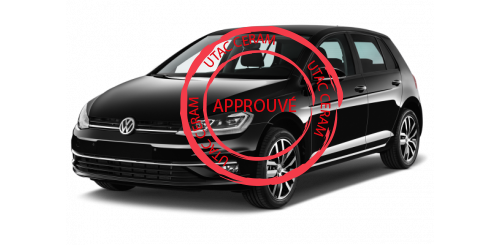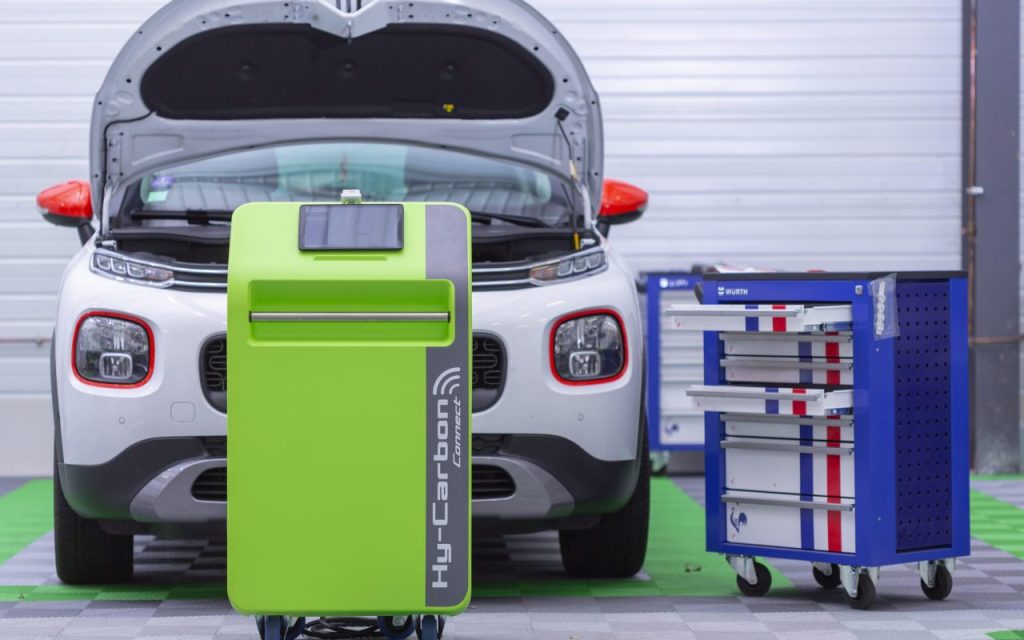Hydrogen descaling –
effective on all types of engines
FlexFuel Energy Development is committed to providing a guaranteed chemical-additive-free solution to the problems of pollutants released by combustion engines. We have carried out tests and demonstrated the effectiveness of our products in a perfectly operational way
Hydrogen descaling – efficiency in numbers
Here, we present a gas analysis, before and after descaling carried out, by UTAC CERAM (Union Technique de l’Automobile, du motocyle et du Cycle, which carries out development, development and validation tests in its laboratories) on a Golf VII.
| Before descaling | After descaling |
| CO2 141.04 g/km | CO2 139.85 g/km |
| CO 197.8 mg/km | CO 168.8mg/km |
| HC 35.84 ppm | HC 28.19 ppm |
| NOx 18.41 ppm | NOx 18.02 ppm |
| PN 2.32E+12 | PN 3,3E+11 |

It can be seen that the vehicle emits less CO2, which indicates better filling of the cylinders. HC (unburned hydrocarbons) are down 21.34% after descaling and CO (carbon monoxide) is also down 14.66%, indicating better diesel combustion (less unburned, complete combustion). NOx (nitrogen oxides) increased from 18.41 ppm to 18.02 ppm, indicating an improvement in the operation of NOx treatment systems.
Hydrogen descaling as seen by the press

Test carried out on a MAN tow truck
| Before | After |
| CO2 1.35 g/km | CO2 0.23 g/km |
| CO 0.005 mg/km | CO 0.002 mg/km |
| HC 2 ppm | HC 0 ppm |
| NOx 205 ppm | NOx 172 ppm |
| Power 53.8 ppm | Power 55.8 ppm |
| Torque 261.2 ppm | Torque 268.8 ppm |

Test carried out on a Clio 1.5l dCi
| Before | After |
| CO2 1.78 g/km |
CO2 1.53 g/km |
| CO 0.02 mg/km |
CO 0.02 mg/km |
| HC 4.9 ppm |
HC 1.13 ppm |
| NOx 48.62 ppm |
NOx 41.23 ppm |
| Power 53.8 ppm |
Power 55.8 ppm |
| Torque 261.2 ppm |
Torque 268.8 ppm |

Test carried out on a Peugeot 806 HDI 110
| Before | After |
| Power 103.7 HP |
Power 108 HP |
| Poor fuel flow regulation | Settled |
| Incorrect boost pressure | Settled |
Test carried out on a Ford Fiesta 1.4 TDCI 68
| Before | After |
| Power 75 HP |
Power 77.5 HP |
| CT refused Opacity 5.98m-1 |
CT accepted Opacity 1.25m-1 |
Descaling analyses on different types of vehicles
Here is an average of the levels of unburned hydrocarbons (HC), nitrogen oxides (NOx) and carbon monoxide (CO) after hydrogen descaling based on 23 analyses of light vehicles

| Result after descaling | |||
| Vehicle | HC | NOX | CO |
| Renault Clio | -77% | -15% | N/A |
| Ford C-Max | -66.34% | -10.22% | -50% |
| Renault Laguna | -40% | -12.09% | -86.36% |
| Renault Mégane 1 | -10.52% | -36.75% | -12.50% |
| Citroën DS3 Racing | -40.85% | -21.86% | -100% |
| BMW X 3I | -19.13% | -4.45% | -40% |
| Renault Scénic III | -87% | -7% | -20% |
| Ford Mondeo Estate | -53.03% | -64.96% | -100% |
Descaling analysis of light commercial vehicles
Here is an average of the levels of unburned hydrocarbons (HC), nitrogen oxides (NOx) and carbon monoxide (CO) after hydrogen descaling based on 8 analyses of light commercial vehicles.

| Result after descaling | |||
| Vehicle | HC | Nox | CO |
| Ford Transit | -99,08% | -49,37% | -100% |
| Peugeot Boxer | N/A | -4,62% | -100% |
| Citroën Jumper | N/A | -15,48% | -51,85% |
| Mercedes Sprinter | -53,83% | -20,16% | N/A |
| Renault Master | -8,98% | -28,58% | -25% |
| Renault Master | -50% | -4,39% | -25% |
| ISUZU Trucks | -66,67% | -20,73% | -50% |
| Renault Trafic | 100% | -91,67% | -96,72% |
As we can see, we are on a decrease of 63.09% on average for HC (unburned hydrocarbons), 20.37% for NOx (nitrogen oxides) and 64.08% for CO (carbon monoxide) which shows an improvement in the health of engines after hydrogen descaling.
N/A: Not Significant
Descaling analysis of heavy commercial vehicles
Here is an average of the levels of unburned hydrocarbons (HC), nitrogen oxides (NOx) and carbon monoxide (CO) after hydrogen descaling established on 8 heavy goods vehicle analyses.

| Result after descaling | |||
| Vehicle | HC | NOX | CO |
| Renault Midlum | -50% | -5.38% | -55.56 |
| Renault Premium | -100% | -15% | -100% |
| Renault D Range | -66.46% | -78.56% | -2% |
| Renault 220 XDI | -2.3% | -79.65% | -28% |
| Man tow truck | -50% | -34.45% | -50% |
| Renault Midliner | -79% | -58% | -21% |
| Irisbus Agora | -97% | -65% | N/A |
| Heuliez GX 317 | -100% | -62% | N/A |
For heavy goods vehicles, we note an average decrease of 68.09% for HC (unburned hydrocarbons), a decrease of 49.75% on average for NOx (nitrogen oxides) and 42.76% for CO (carbon monoxide).
On each type of vehicle, whether light vehicles, light commercial vehicles or heavy goods vehicles, there is a decrease in engine pollution following hydrogen descaling This decrease can be explained both by an improvement in combustion and by a complete cleaning of the engine and its pollution control system. This improvement in engine efficiency also allows a very significant reduction in consumption.
Not significant
Descaling analysis of Boat
This analysis was made on one of the Bateaux Vedettes de Paris.
| Port | |
| Before descaling | After descaling |
| O2 19% |
O2 19.50% |
| CO2 1.28% |
CO2 0.88% |
| CO 0.01% | CO 0% |
| HC 5.54 ppm | HC 3.29 ppm |
| NOx 153.55 ppm |
NOx 64.67 ppm |
Here, the descaling was carried out on a Caterpillar 6L2 engine. We can see that the boat emits less CO2 (31.25% less compared to the value before descaling up). Similarly, unburned hydrocarbons have decreased from 5.54 ppm to 3.29 ppm, which is a good indication of better diesel combustion. Nitrogen oxide (NOx) also experiences a sharp drop after descaling (57.88% less than the initial value), indicating an improvement in the efficiency of the operation of the NOx treatment system.
| Starboard | |
| Before descaling | After descaling |
| O2 19.10% | O2 18.62% |
| CO2 1.50% | CO2 1.18% |
| CO 0.01% | CO 0.01% |
| HC 5.31 ppm | HC 4.87 ppm |
| NOx 114.28 ppm | NOx 73.88 ppm |
As with the Caterpillar 6L2 engine on the port side, there is a reduction in CO2, a better combustion of diesel (a decrease in the level of unburned hydrocarbons) and a better efficiency in the operation of the NOx treatment system.
Overall, after descaling on this type of boat, we have a reduction in engine pollution which can be explained both by an improvement in combustion as well as a complete hydrogen cleaning of the engines. This improvement in engine efficiency also allows for a significant reduction in consumption but also a better impact on the environment thanks to the reduction of CO2 and NOx emissions.


